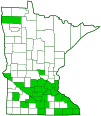nodding spurge
(Euphorbia nutans)
Conservation • Wetland • Description • Habitat • Ecology • Use • Distribution • Taxonomy
Description |
||
Nodding spurge is a low, spreading, 3″ to 12″ tall, annual forb that rises from a taproot. All parts of the plant emit a milky sap when broken. The stems are thick, round, up to 32″ long, and frequently branched at the base. They are ascending or erect, never prostrate. They are usually ascending, sometimes just at the branch tips. They are tan or pinkish-tan, becoming reddish in strong sun. They are sparsely to moderately covered with curved hairs toward the stem tips and around the nodes. Older parts of the stem are hairless or nearly hairless. Sometimes the hairs occur in two lines on opposite sides of the stem. The plant does not root at the nodes. Leaves are opposite, oblong or oblong egg-shaped, and stalkless or on very short leaf stalks. The leaf blades are 5 ⁄16″ to 1½″ long about a third as wide. They are bluntly-pointed at the tip, rounded and asymmetrical at the base. The base of the blade on one side is expanded into a small, rounded, ear-like projection (auricle). The upper and lower surfaces are usually sparsely to moderately hairy near the base, sometimes hairless. The upper surface is deep green, often with a reddish spot near the middle. The lower surface is pale green but is not covered with a whitish, waxy bloom (glaucous). The margins are finely toothed. What appear to be flowers are actually false flowers (cyathia) common to the Euphorbiaceae (spurge) family. The inflorescence is usually a small, leafy cluster of cyathia, sometimes a single cyathium, rising from a leaf axil. The cyathium is less than ⅛″ wide. It is on a stalk up to ⅛″ long. There are no petals or sepals. A single floral bract is formed into a hairless, 1 ⁄32″ long cup (involucre). There are 4 white or pinkish, spreading, petal-like lobes at the tip. There are 5 to 28 male flowers and a single female flower in the cyathium. The male flower has 1 stamen. The female flower has a 3-valved, hairy, seed capsule hanging alongside the involucre. The fruit is a 3-lobed, hairy capsule with 3 seeds. |
||
Height |
||
3″ to 12″ |
||
Flower Color |
||
White or pinkish |
||
Similar Species |
||
Spotted spurge (Euphorbia maculata) stems are prostrate. The plant is usually less than 1″ tall. Prostrate knotweed (Polygonum aviculare) does not emit milky sap from broken stems and leaves. It has a sheath that surrounds the stem above each leaf axil. |
||
Habitat |
||
Dry to moist. Pastures, fields, open woods, lawns, gardens, and disturbed sites. Full sun. |
||
Ecology |
||
Flowering |
||
June to October |
||
Pests and Diseases |
||
|
||
Use |
||
|
||
Distribution |
||||
|
Sources |
|||
| 4/9/2023 | ||||
Nativity |
||||
Native |
||||
Occurrence |
||||
|
||||
Taxonomy |
|||
| Kingdom | Plantae (Plants) | ||
| Subkingdom | Pteridobiotina | ||
| Phylum | Tracheophyta (Vascular Plants) | ||
| Class | Magnoliopsida (Dicots) | ||
Order |
Malpighiales (Nances, Willows, and Allies) | ||
Family |
Euphorbiaceae (spurge) | ||
| Subfamily | Euphorbioideae | ||
| Tribe | Euphorbieae | ||
| Subtribe | Euphorbiinae | ||
Genus |
Euphorbia (spurges) | ||
| Subgenus | Chamaesyce | ||
| Section | Anisophyllum (sandmats) | ||
Nodding spurge was formerly classified as Chamaesyce nutans. Species were originally assigned to the genus Chamaesyce based on the structure of the reproductive organs. Genus wide molecular studies in 2002, 2006, 2007, and 2010 have all unequivocally placed them in the genus Euphorbia, where they were subsequently transferred. |
|||
Subordinate Taxa |
|||
Synonyms |
|||
Chamaesyce maculata Chamaesyce nutans Chamaesyce preslii Euphorbia maculata Euphorbia maculata Euphorbia preslii |
|||
Common Names |
|||
eyebane nodding spurge spotted sandmat spotted spurge |
|||
Glossary
Auricle
A small, ear-like projection at the base of a leaf or at the junction of a grass blade and stem.
Axil
The upper angle where the leaf stalk meets the stem.
Bract
Modified leaf at the base of a flower stalk, flower cluster, or inflorescence.
Cyathium
The false flower of the spurge (Euphorbiaceae) family, consisting of a cup-like involucre surrounding a cluster of small flowers.
Glaucous
Pale green or bluish gray due to a whitish, powdery or waxy film, as on a plum or a grape.
Involucre
A whorl of bracts beneath or surrounding a flower, flower head, or flower cluster.
Node
The small swelling of the stem from which one or more leaves, branches, or buds originate.
Sepal
An outer floral leaf, usually green but sometimes colored, at the base of a flower.
Visitor Photos |
|||||
Share your photo of this plant. |
|||||
| This button not working for you? Simply email us at info@MinnesotaSeasons.com. Attach one or more photos and, if you like, a caption. |
|||||
|
|||||
MinnesotaSeasons.com Photos |
|||||
Plant |
|||||
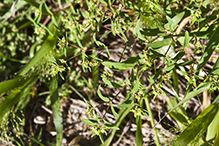 |
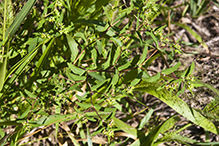 |
||||
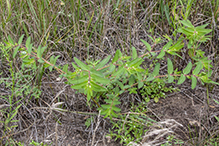 |
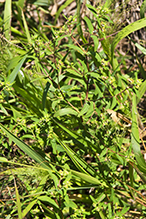 |
||||
Inflorescence |
|||||
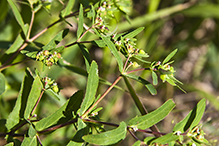 |
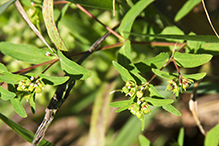 |
||||
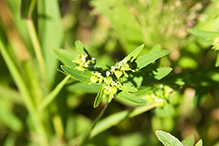 |
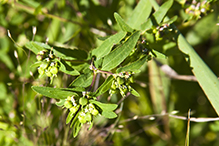 |
||||
Leaf Underside |
|||||
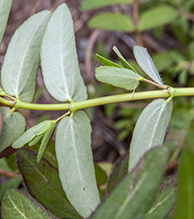 |
|||||

Slideshows |
||

Visitor Videos |
|||
Share your video of this plant. |
|||
| This button not working for you? Simply email us at info@MinnesotaSeasons.com. Attach a video, a YouTube link, or a cloud storage link. |
|||
Other Videos |
|||

Visitor Sightings |
|||||
Report a sighting of this plant. |
|||||
| This button not working for you? Simply email us at info@MinnesotaSeasons.com. Be sure to include a location. |
|||||
|
|||||
MinnesotaSeasons.com Sightings |
|||||

|
Created: Last Updated: © MinnesotaSeasons.com. All rights reserved. |
